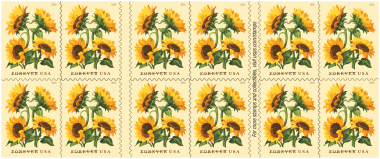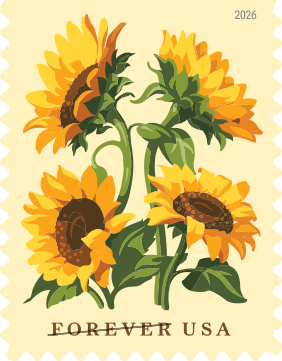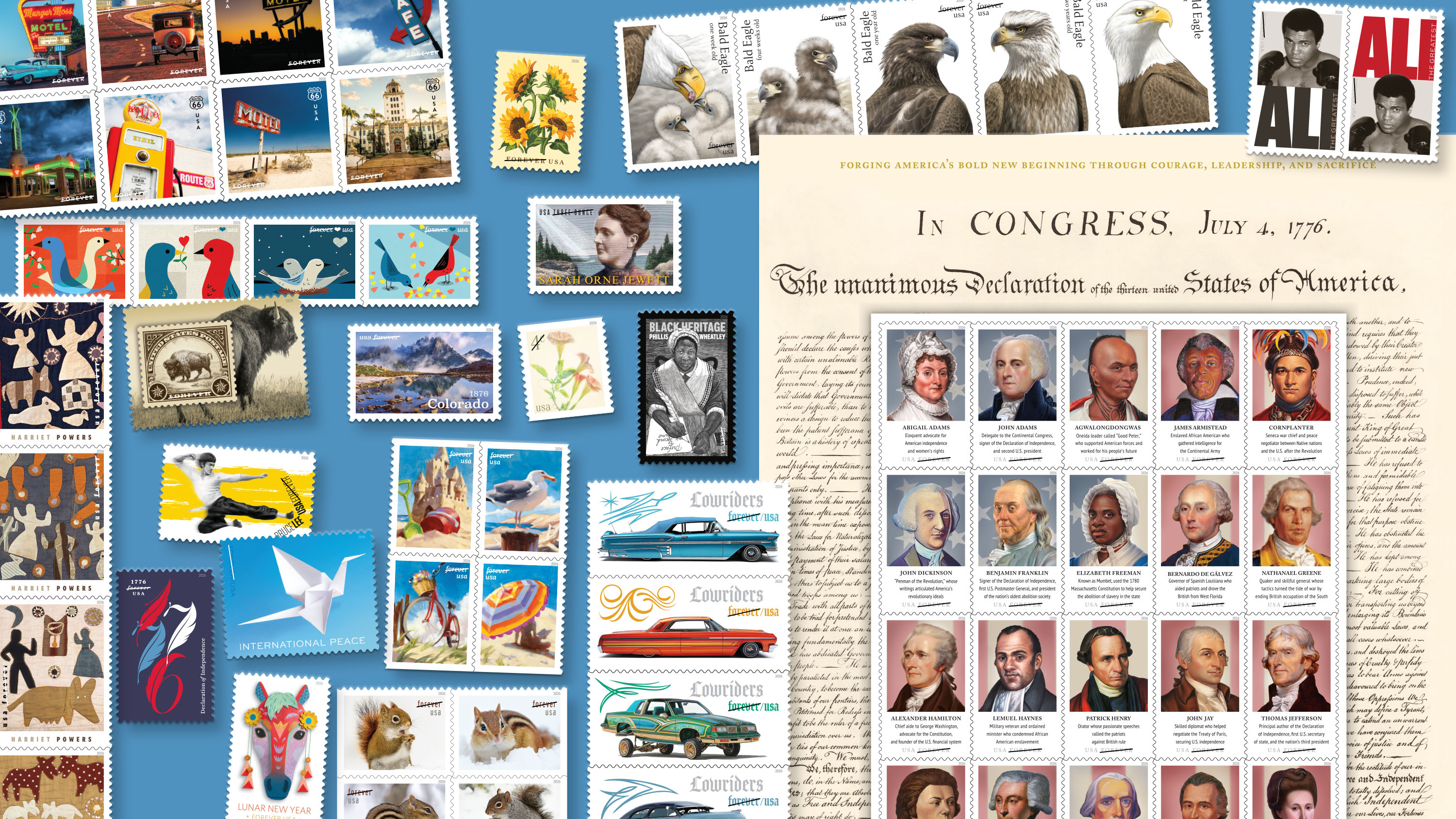
About This Stamp
With the 2026 Sunflowers stamp, the U.S. Postal Service celebrates a versatile native flower recognized for its beauty, nutritional benefits, economic significance, and ecological contributions.
Prized by both gardeners and pollinators, the sunflower (Helianthus annuus) takes its scientific name from the Greek word helios, meaning “sun,” and anthus, meaning “flower.” Aside from common sunflowers, more than 50 distinct species of annual and perennial sunflowers grow within North America. Similar to other heliotropic plants like the alpine buttercup and Arctic poppy, young sunflowers follow the sun’s trajectory from east to west throughout the day. This sun-tracking behavior diminishes as the plant matures, and its stem becomes more stationary and rigid.
A dependable source of nectar and seeds, sunflowers are a favorite food plant for birds, bees, and butterflies. They also offer sustainable benefits including drought resistance, soil rejuvenation through their deep taproots, and natural pest control in gardens and on farms. While sunflowers are hardy, easy to grow, and tolerate both dry conditions and poor soil, true to their name, they do require plenty of sunshine.
Designed by art director Greg Breeding, the Sunflowers stamp continues a long tradition of highlighting native flowers on USPS stamps. In addition to sunflower stamps in 2008 and 2012, past native wildflower issuances include the 1992 American Wildflowers pane, Wild Orchids (2020), and Mountain Flora (2022), among many others.
The stamp art features four stylized sunflowers rendered in yellow, gold, and brown, with leaves and stems in shades of green against a pale yellow background. Using photographic references, illustrator Nancy Stahl sketched the initial drawing in ink, then used a vector drawing application to apply final color. “I always try my best to make my drawings approachable, interesting takes on what often are familiar subjects,” says Stahl. “I was fascinated by the underside of the sunflower’s bloom — how the stem is topped off with an almost petal-like double ring of small green leaves. The Fibonacci pattern made by the seeds at the center on the front side was mesmerizing once I dove into it.”
Stahl has designed more than 40 stamps for the U.S. Postal Service on a variety of subjects. She is especially well known for her highly stylized animal stamps, including the 2024 Save Manatees stamp.
The Sunflowers stamp is being issued as a Forever® stamp. This Forever stamp will always be equal in value to the current First-Class Mail® one-ounce rate.
Stamp Art Director, Stamp Designer

Greg Breeding
Greg Breeding is a graphic designer and principal of Journey Group, a design company he co-founded in 1992, located in Charlottesville, Virginia. He was creative director until 2013, at which time he began serving as president and continued in that role through 2023.
Breeding’s fascination with modernism began while studying design at Virginia Commonwealth University. His affinity with the movement continues and motivates his ongoing advanced studies at the Basel School of Design in Switzerland most every summer.
As an art director for postage stamp design since 2012, Breeding has designed more than 100 stamps covering a diverse array of subjects, from Star Wars droids and Batman to Harlem Renaissance writers and the transcontinental railroad.
His work has been recognized in annual design competitions held by Graphis, AIGA, PRINT magazine, and Communication Arts.
Breeding lives in North Garden, Virginia, with his wife and enjoys nothing so much as frolicking on the floor with his grandchildren.
Stamp Artist

Nancy Stahl
A native of Long Island, New York, Nancy Stahl studied art at the University of Arizona, the Art Center College of Design in Los Angeles, and the School of Visual Arts in New York City. Her career can be split nearly equally between traditional media and digitally created art. Originally working in graphite, she experimented with a variety of media before making gouache paintings her signature style. She learned to work digitally starting in 1989 and abandoned her paints a few years later.
Stahl’s clients have ranged from newspapers and magazines such as The New York Times, The Wall Street Journal, TIME magazine, and Der Spiegel to corporate identity, packaging and billboards for companies such as The Disney Family Museum, Sharffen Berger chocolates, and Stonyfield Farms. Her love of craft has allowed Stahl to accept assignments as varied as creating lace for the Metropolitan Museum of Art’s Costume Institute and knitting Christmas stamp designs in 2005 for the US Postal Service.
Her work is represented in The Illustrator in America, 1860–2000 by Walt Reed and Rolling Stone: The Illustrated Portraits edited by Fred Woodward. An instructor in the Independent Study Masters Degree program at Syracuse University, Stahl has also taught illustration at the School of Visual Arts and the Fashion Institute of Technology. In 2012, She was elected to the Society of Illustrators Hall of Fame.
Stahl works from her studio in New York City where in her leisure time she pursues her hobby of computerized knitting.
She has designed more than 40 stamps for the U.S. Postal Service including the New York Public Library Lion (2000), three stamps for the Stars and Stripes issuance (2015), 19th Amendment: Women Vote (2020), and Women's Rowing (2022). Stahl is especially well known for her highly stylized animal stamps, including Bighorn Sheep (2007); the Save Vanishing Species semipostal (2011, reissue 2014), featuring a portrait of an Amur tiger cub; Penguins (2015); Frogs (2019); and Save Manatees (2024). Most recently, Stahl illustrated the 2026 Sunflowers stamp.

